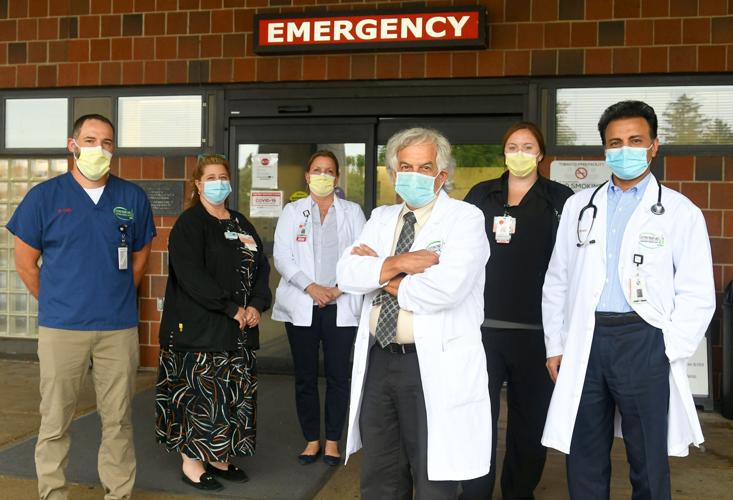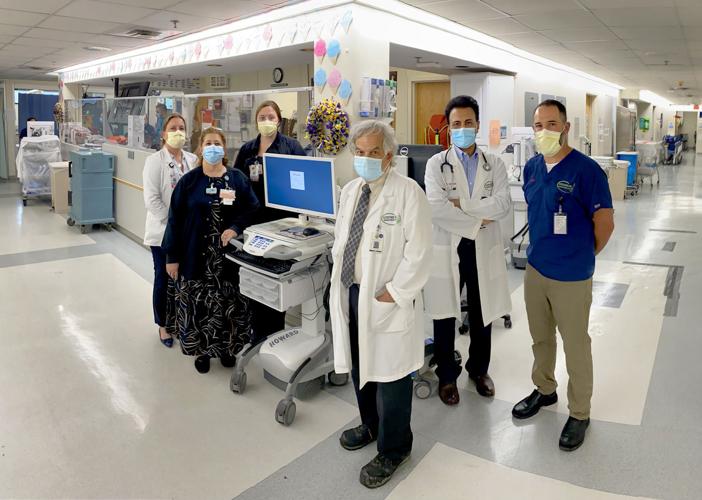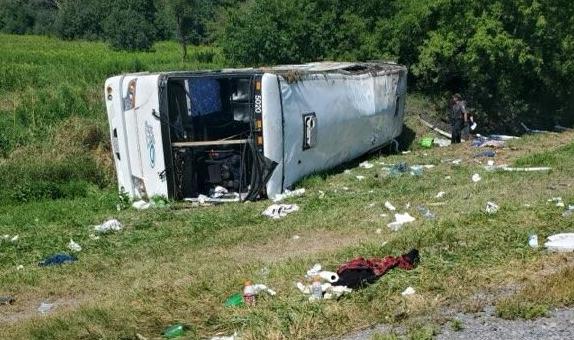AUBURN — Dr. Shakeel Usmani, on a rare day off, had reserved a tee time to play golf with his son.Â
Moments later, he received the message that altered his afternoon plans on Saturday, Aug. 14.Â
A bus carrying 57 people rolled over about one mile west of the Weedsport Thruway exit. The crash was reported at 12:41 p.m., according to the New York State Police.Â
As ambulances and fire trucks raced to the scene, the staff in Auburn Community Hospital's emergency room put their training for mass casualty incidents into action.Â
ER nurse manager Courtney Seamans was informed by the charge nurse and emergency medical services personnel that there was a bus crash on the Thruway. At that point in the response, it was unknown how many patients would be sent to the hospital.Â
People are also reading…
A tour bus rolled over while traveling westbound on the state Thruway near Weedsport Aug. 14.
Dr. Timothy Cobb, who was the on-duty ER doctor when the crash occurred, notified the other emergency room doctors — the four physicians arrived with 90 minutes, he said. Text messages were sent to other employees, including nursing staff, asking them if they could come into work. Seamans said 57 employees who received the messages came to work that day.Â
When the ambulances began to arrive at the emergency room, Cobb said it was like a scene in the hit TV series "Grey's Anatomy."Â
"Usually we're accustomed to one ambulance, one patient. That's how they usually come," he said. "But they were coming two at a time, so that was a little scary."Â
With an influx of patients coming into the emergency room, Auburn hospital activated its incident command system. Tammy Sunderlin, the hospital's chief nursing officer and vice president of patient care services, explained that required all employees to remain in the hospital. They had to be ready if the emergency room needed their assistance.Â
The emergency room was full before the crash, according to Sarah Lormand, clinical director at Auburn Community Hospital. Those patients were moved to rooms in the hospital so that the emergency room was open for the bus crash victims.Â
As the injured passengers arrived, medical personnel triaged the patients. The emergency room was used for more serious injuries. A temporary emergency room was set up in the post-anesthesia care unit, or PACU, for what Seamans called "walkie-talkie patients" — those with minor injuries that required minimal care. Fourteen of the bus passengers were transported from the crash scene on a Centro bus. Once they arrived at the hospital, they were registered and triaged before being transferred to the makeshift emergency room.Â
Auburn hospital received 28 of the 57 crash victims. By Sunday, 20 of the patients were discharged. The remaining eight patients were either transferred to Upstate University Hospital in Syracuse or, in one case, to Strong Memorial Hospital in Rochester.Â
Dr. Patsy Iannolo, the hospital's chief of emergency medicine, said there are certain traumatic injuries that require specialized treatment not available in Auburn. The medical team at Auburn stabilized patients with serious injuries before they were transferred to hospitals in Rochester or Syracuse.Â
What helped expedite the diagnoses of many patients was the use of two CTs and other radiology equipment. The technicians went to each room to perform CT scans and X-rays to determine the extent of the injuries. Those images were sent to Rochester to be processed.Â
"We were bombarding them with more CAT scans than they've ever seen and they turned around the readings pretty quickly," Iannolo said.Â
There was a hurdle that doctors and nurses faced as they treated more than two dozen patients. Some of the injured passengers spoke Spanish but not English. Medical staff used what Sunderlin called an "interpreter on wheels," a computer that can help bridge the communication gap. They also were aided by a social worker's family members who are fluent in Spanish. A hospitalist and surgeon also speak Spanish, so they were able to assist. Family members with less severe injuries were helpful, too.
The consensus among the emergency room staff and hospital leadership is that their policies and procedures for mass casualty incidents worked.Â
"It was nice to actually put it into play and see how it actually worked in real life," Seamans said.Â
Iannolo sought to downplay the significance of the moment — "we're trained for this," he said — but acknowledged that it was a great effort. Within four hours, the emergency room stabilized and treated nearly 30 patients. Cobb said he was able to go home on time because of the quick work.Â
Usmani missed the golf outing with his son, but was amazed at the work of his emergency room colleagues.Â
"Everybody stood up as a team," he said. "Within a few hours, we were able to treat them."Â
Politics reporter Robert Harding can be reached at (315) 282-2220 or robert.harding@lee.net. Follow him on Twitter @robertharding.

















